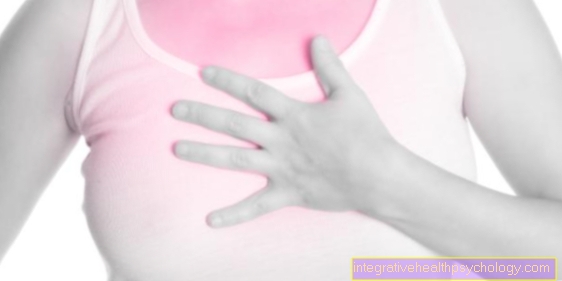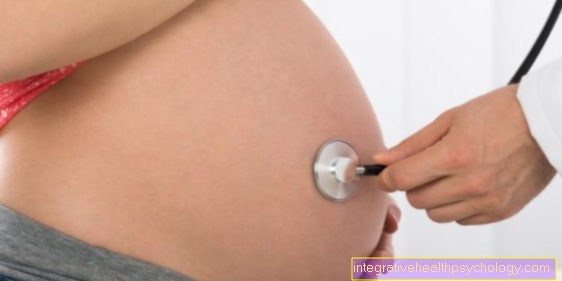Heart Muscle Inflammation From Exercise - How Dangerous Is It?
introduction
Myocarditis (Myocarditis) can arise from a variety of causes. If it is caused by viral or bacterial pathogens, there is a drastically increased risk of sudden cardiac arrest and death as a result of this disease with physical exertion. Almost 5% of sudden cardiac deaths develop on the basis of a dragged viral infection! For this reason, physical rest should be taken when a virus-induced myocarditis is diagnosed.

Development of myocarditis
It is noticeable that there is a significantly higher incidence of myocarditis during the cold season. This is because during this period there is an increased risk of contracting a flu virus. On the one hand, these viruses trigger the typical symptoms of a flu or cold, i.e. above all fever, tiredness and fatigue, joint and limb pain and possibly cough and / or runny nose. As a rule, this disease heals without complications. However, if an affected person exerts himself too much physically, i.e. does a lot of sport, then there is a possibility that the viruses could spread in the body. In the worst case, the viruses attack the heart muscles and damage them, which leads to inflammation of the heart muscle.
Also read our topic: Exercise for coughs
In this case, the human immune system “confuses” the viruses with cells of the heart's muscles, as these are similar in their surface structure and then attacks its own body cells instead of the viruses. However, a few pathogens also damage the heart muscle through a direct attack, including, for example, the diphtheria-causing bacteria or borrelia. In principle, this can always happen once the virus has entered the body, but the risk is greatly increased under physical strain. For this reason, flu sufferers are advised to take a training break of around two to three weeks from the onset of their illness. After this period of time, during which it is best to keep bed rest, the patient can slowly begin to resume normal sporting activities.
You might also be interested in that: Exercise after a cold - from when?
The tricky thing about the disease is that the heart muscle inflammation does not directly trigger symptoms. Those affected often experience weakness, cardiac arrhythmias, palpitations and / or heart pain. However, these symptoms can also be very mild or completely absent, so that a patient does not even notice the potentially life-threatening inflammation. However, if the body continues to be exposed to stresses that it cannot cope with in this state, acute deterioration can occur, which in the worst case leads to sudden cardiac arrest.
Heart muscle inflammation associated with exercise
If you do not want to stop exercising despite having a cold or flu, you should definitely see a doctor. He can examine the patient in detail and perform an EKG and a blood analysis as part of this examination. Any arrhythmias that may be present can be detected very well and early on in the ECG. In the blood, particular attention is paid to the so-called CRP value. This is an inflammation parameter that is increased in inflammatory processes in the body triggered by pathogens. If a certain value is exceeded, it is advisable to take a break from training. When the blood values and the EKG have normalized again, you can safely resume training.
Of course, you don't have to spend several weeks in bed at the slightest sign of a cold, but you shouldn't overuse yourself or underestimate the disease. If in doubt, it is best to always consult a doctor and get his advice and take it easy for a little too long rather than not long enough.
The sudden cardiac arrest in heart muscle inflammation is caused by the weakening of the muscles. Certain areas are infected by viruses and can no longer work properly because they are inflamed and / or have been killed by the immune system. On the one hand, the heart reacts with an accelerated pulse (palpitations), and on the other hand, the transmission of excitation can be so impaired that rhythm disturbances exist. In the worst case, the heart is not able to compensate for this condition if it is exposed to increased stress, such as occurs during sporting activities. The heart has to beat faster and stronger, pump more blood into the body in the same period of time in order to adequately supply the muscles. As a result, it can ultimately happen that it can no longer withstand this pressure and completely ceases to work.
Common cold and myocarditis
Especially when you have a feverish infection or a flu-like infection, it is best to avoid sport.
Even a normally harmless cold, which may not make you feel very sick, can precede myocarditis. Most heart muscle inflammation, however, is caused by viruses.
Often are so-called Coxsackie B and Parvovirus B19 Viruses responsible for myocarditis. These penetrate the body and reach the heart via the bloodstream, where they damage the muscle cells. In order to reduce the risk of heart muscle inflammation, it is important during the time of the infection, in the end it does not matter whether it is accompanied by or without a fever, to take it easy and, above all, not to engage in any sporting activities.
The inflammation of the heart muscle cells, possibly caused by a cold, can continue through physical stress.fired“And get worse. It is therefore important to take care of yourself in the event of a cold or an infection.
Symptoms of myocarditis
If heart muscle inflammation is suspected, then it is best to refrain from increased physical stress and from exercising.
Normally, during sport or during increased physical exertion, the heart does a lot more work to transport more oxygen to the individual organs. Since the heart is attacked and damaged by an inflammation of the heart muscle, the heart can no longer do this extra work.
In the worst case, acute heart failure can occur.
It is possible that you notice this at the beginning of an inflammation of the myocardium, especially during increased physical exertion or during sporting activities, as the heart has to do more work. The first symptoms that the affected patient notices, for example, can be unusually quick fatigue under otherwise usual training conditions for the patient.
You may need significantly more time for your usual jogging lap, or you can only manage half the distance. Another symptom can be sudden shortness of breath. Pain in limbs during exercise can also be a symptom of myocarditis. The affected patient may also experience increased heart stumbling during exercise.
Read more on the topic: Symptoms of myocarditis
Consequences of an inflammation of the heart muscle
The consequences of exercise despite an inflammation of the heart muscle can be manifold and range from the uncomplicated healing of the inflammation to the loss of a large part of the heart's function. The performance of a heart is measured by how much blood can be circulated by the contraction of the heart and also how well the heart can respond to exertion by increasing the pump function. If the myocarditis is not cured sufficiently, heart muscle cells are permanently damaged. The more of these cells die, the greater the functional limitations of the heart. The heart is no longer able to circulate the physiological amount of blood - about 70ml per heartbeat - and so-called heart failure develops, in which the blood backs up in the body and water deposits in the body, so-called edema, occur .
A reaction of the heart to a higher load such as strenuous sport is no longer possible for these patients and in the worst case can lead to cardiac arrhythmias or even cardiac arrest.
How long should you not do sports after an inflammation of the heart muscle?
The opinions of experts differ somewhat on this question. While some sources recommend three months of exercise abstinence, there are others that even consider a six-month break from exercise to be correct. In any case, before resuming training or any other physical exertion, affected patients should see a cardiologist to have the heart's pumping function checked. So you don't run the risk of stressing yourself too early.
The prescribed ban on sports should be consistently adhered to during this time in order to counteract the risk of consequential damage such as dilation of the heart or restriction of the pumping function.The same restrictions also apply to everyday working life. Here, too, it is important to avoid physical exertion. Those affected should therefore be on sick leave or be transferred to another department while they are recovering, provided that they normally have a strenuous activity.
Read more about this under Duration of an inflammation of the heart muscle.
Can the disease be fatal?
In general, it cannot be ruled out that an inflammation of the heart muscle will ultimately lead to death. However, this is the worst case to be assumed and is given in the specialist literature with a risk of just under five percent.
It should also be noted that sport does not lead to myocarditis, but sport can lead to an overload of the heart with existing myocarditis, which can lead to cardiac arrhythmias and ultimately death. During the inflammation, the heart only has a fraction of its actual capacity and is therefore not able to generate enough pumping power during intense physical exertion without suffering permanent damage.























.jpg)





